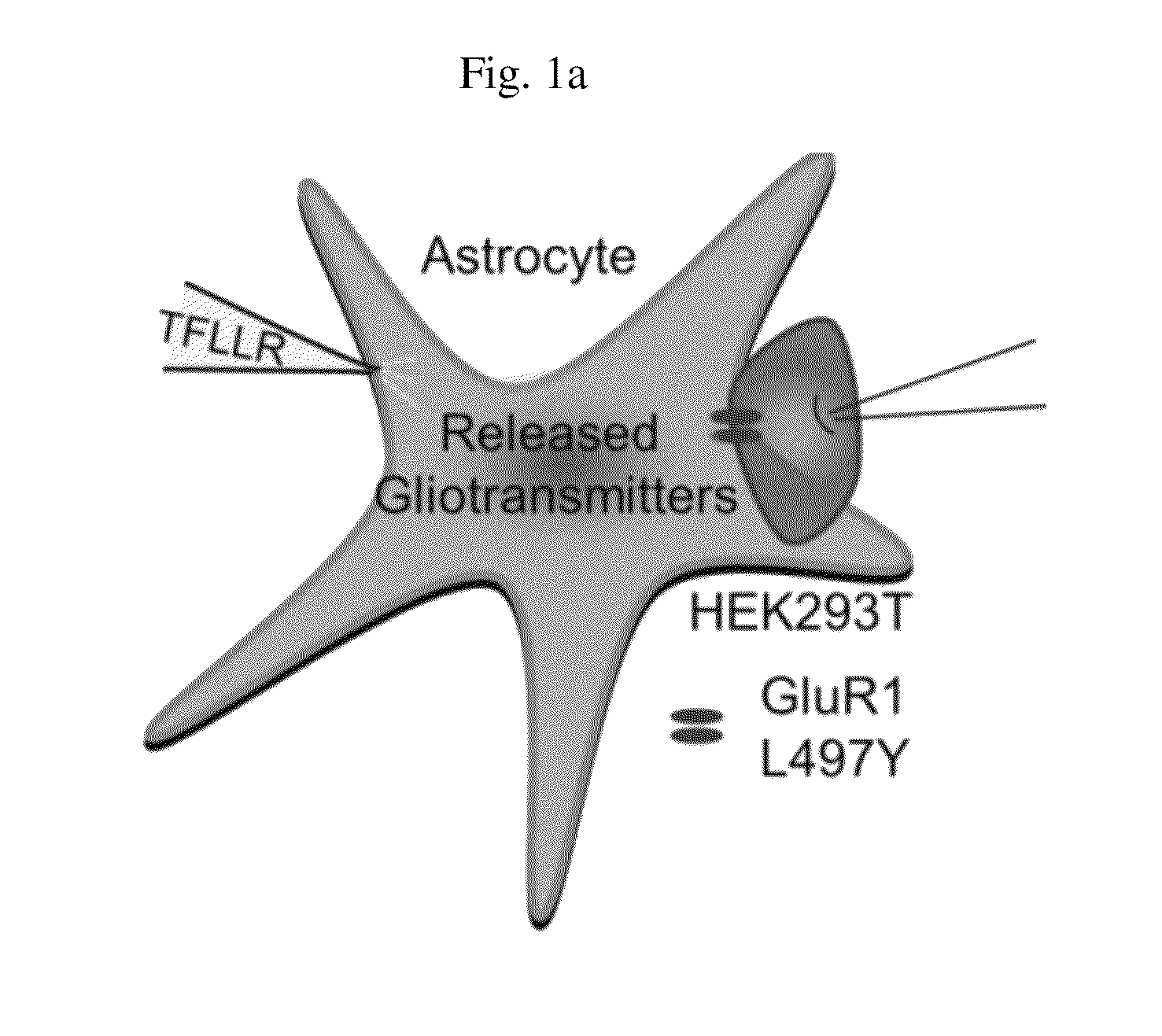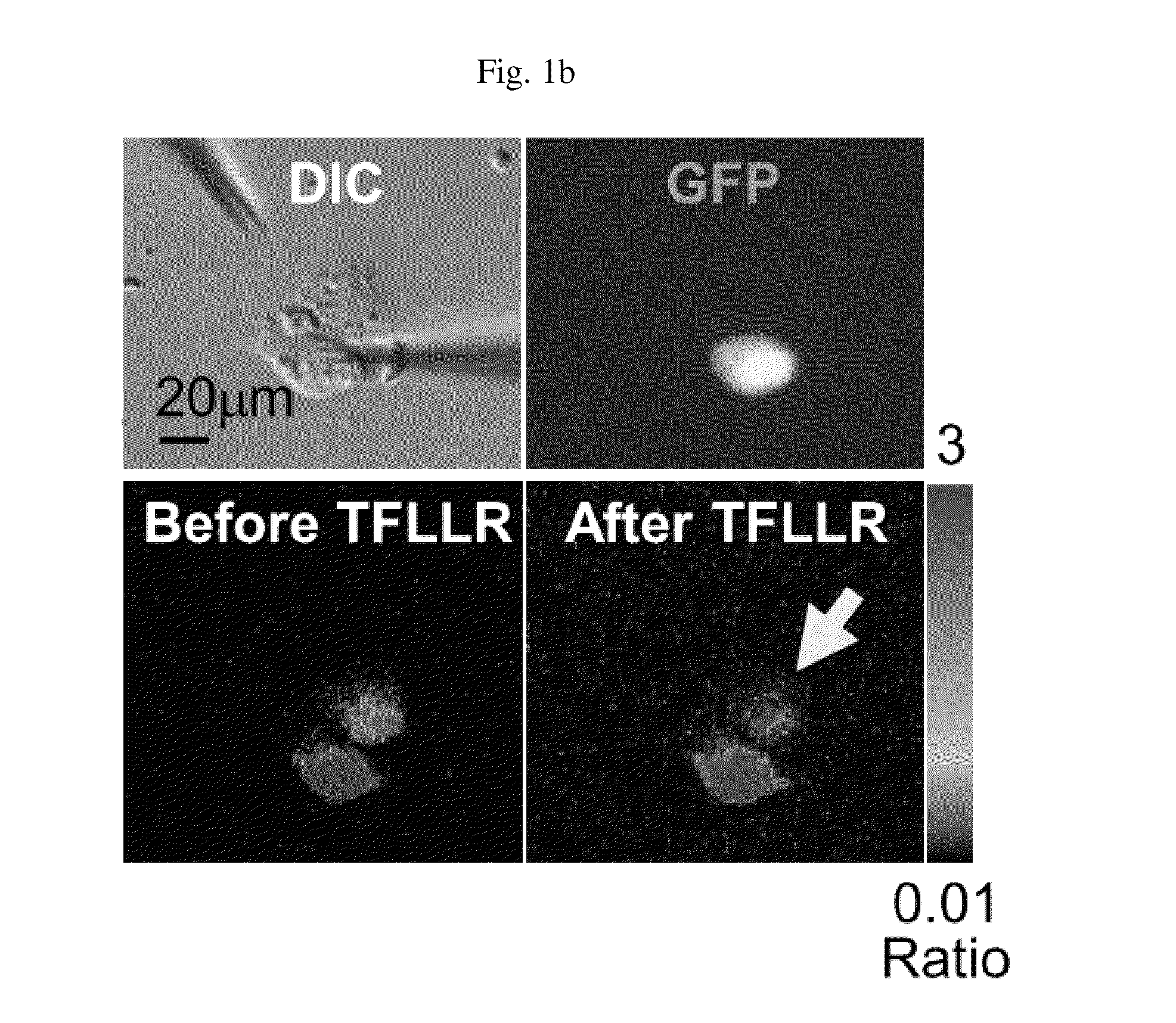Method for screening a glutamate release inhibitor in an astrocyte
- Summary
- Abstract
- Description
- Claims
- Application Information
AI Technical Summary
Benefits of technology
Problems solved by technology
Method used
Image
Examples
example 1
Characterization of Fast and Slow-Modes of Glutamate Release
[0249]1-1. Effect of Ca2+ Concentration in an Astrocyte on the Glutamate Release
[0250]To examine the signaling pathways mediating the fast and slow-modes of glutamate release, we utilized various molecular and pharmacological tools. Because the PAR1 receptor is linked to both G110 and G02, we selectively inhibited the Gi pathway by pre-incubating astrocytes with pertussis toxin (PTX), which is known to inhibit the action of Gi subunit by ADP-ribosylation. Specifically, for blocking Gi signaling pathway, astrocytes were pretreated with culture media containing 1 μg / ml Pertussis Toxin (PTX) for 12-20 hrs before sniffer-patch and then performed for sniffer-patch (see Experimentations 3-1 and 3-3). The results were shown in FIG. 1e, FIG. 1f, FIG. 1g, FIG. 9a and FIG. 9b.
[0251]As shown in FIG. 1e, FIG. 1f, FIG. 1g, FIG. 9a and FIG. 9b, we found that PTX selectively and almost completely blocked the fast but not the slow compone...
example 2
Molecular Identity of Fast and Slow-Modes of Glutamate Release
[0272]2-1. Identification of Fast-Mode Release
[0273]We examined the possibility that TFLLR induces glutamate release from astrocytes via channels or transporters. We screened blockers of various channels and glutamate transporters and found that both the fast and slow-modes of release were blocked by blockers of Ca2+-activated anion channel (CAAC), such as NPPB, niflumic acid, DIDS (4,4′-Diisothiocyano-2,2′-stilbenedisulfonic acid) (FIG. 2e, 11a, and 11b), and quinine, which blocks two-pore potassium (K2P) channels (FIGS. 2f and 11c). Although these blockers are notorious for their non-specific effects, they did not have any effect on the sensor cell, GluR1-L497Y receptor (FIG. 11d and 11e). Blockers that did not show any significant effect include TTX (voltage-gated sodium channels), Cd2+ (voltage-gated Ca2+ channels), TEA, Ba2+, Cs+ (potassium channel), CBX (gap-junction hemichannel), and DCPIB (volume-sensitive anion c...
example 3
Opening of Glutamate-Permeable Channel by Direct Binding of Gβγ to TREK-1
[0279]3-1. The N-Terminal of TREK-1
[0280]TREK-1-mediated glutamate release is relatively fast and requires Gi-Gβγ□ dissociation. To answer the question, we considered a possibility that Gβγ directly binds to TREK-1 to open a glutamate-permeable channel. A previous yeast two-hybrid screen indicated that TREK-1 interacts with GNG4 (subtype 4 of Gγ□ subunit). The experiment was performed according to the two yeast hybrid screening method of Experimentation 5, and the full down assay of Experimentation 6. The results were shown in FIGS. 3a to 3c, FIG. 12b and FIG. 12c.
[0281]Therefore, we performed a detailed analysis of N-terminal region of TREK-1 (FIG. 3a). Of the 4 segments of N-terminal region of TREK-1, each with 11 or 12 amino acid residues, we found that the N1, N2, and N4 segments strongly interacted with GNG4, while N3 did not (FIGS. 3a, 3b, and 12b). The interaction of TREK-1 N-terminus with GNG4 was also...
PUM
| Property | Measurement | Unit |
|---|---|---|
| recovery time | aaaaa | aaaaa |
| thickness | aaaaa | aaaaa |
| pH | aaaaa | aaaaa |
Abstract
Description
Claims
Application Information
 Login to View More
Login to View More - R&D
- Intellectual Property
- Life Sciences
- Materials
- Tech Scout
- Unparalleled Data Quality
- Higher Quality Content
- 60% Fewer Hallucinations
Browse by: Latest US Patents, China's latest patents, Technical Efficacy Thesaurus, Application Domain, Technology Topic, Popular Technical Reports.
© 2025 PatSnap. All rights reserved.Legal|Privacy policy|Modern Slavery Act Transparency Statement|Sitemap|About US| Contact US: help@patsnap.com



